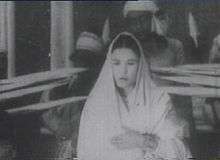Joymoti Konwari
Joymoti Konwari, was the wife of Tai-Ahom Prince Gadapani (later Supatphaa). She was accorded the honorific Mohiyokhi on account of her heroic endurance of torture until the end, dying at the hands of royalists under Sulikphaa Loraa Roja without disclosing her exiled husband Prince Gadapani's whereabouts, thereby enabling her husband to rise in revolt and assume kingship. Gadapani and Joymoti's son Rudra Singha had the Joysagar Tank dug at the spot where she was tortured. The first Assamese film Joymoti, directed in 1935 by Jyoti Prasad Agarwala, was based on her life.[1]
Joymoti Konwari | |
|---|---|
| Born | Madurigaon, Sivasagar, Assam |
| Died | Jerenga Pathar, Sivasagar |
| Other names | Jaynmoti |
| Spouse(s) | Gadadhar Singha |
| Children | Lai Lechai |
| Parent(s) | Laithepena Borgohain and Chandradaru |
Biography
Joymoti was born in the middle of the 17th-century in Maduri to Laithepena Borgohain and Chandradaru. She was married to Langi Gadapani Konwar,[2] later an Ahom king, Supatphaa, who established the Tungkhunia line of kings. During the Purge of the Princes from 1679 to 1681 under King Sulikphaa (Loraa Roja), instigated by Laluksola Borphukan, Gadapani took flight. Over the next few years, he sought shelter in the Naga hills.[3]
Failing to trace Prince Gadapani, Sulikphaa's soldiers brought his wife Joymoti to Jerenga Pathar where, despite torture, the princess refused to reveal the whereabouts of her husband. After continuous physical torture over 14 days, Joymoti died on 13 Choit of 1601 Saka, or 27 March 1680.[4]
Memorials & monuments
Joysagar Tank
Joymoti and Gadadhar Singha's eldest son Lai succeeded his father. He took on the Hindu name Rudra Singha (Sukhrungphaa, 1696–1714). In honour of the memory of his mother Joymoti, Rudra Singha built the Joysagar Tank in 1697 at Sibsagar. It is believed to be the biggest man-made lake in India,[5] comprising an area covering 318 acres (1.29 km2) of land, including its four banks,[6] out of which 155 acres (0.63 km2) is filled with fresh water. A 2 km-long earthen water pipeline once ran from the tank to the Rangpur Palace (Kareng Ghar), supplying water to the royal palace.
Fakuwa Dol
Rudra Singha also built the Fakuwa Dol in 1703–04, a pyramid-shaped temple constructed before the Rangnath (Shiva) Temple on the banks of the Joysagar Tank. It is said that Rudra Singha, once again to perpetuate the memory of his mother Soti Joymoti, constructed the temple and placed a golden idol of her within it. It was actually a moidam (grave) of Joymoti. The circumference of the Dol was about 90 ft (27 m), and its height from base to top was 30 ft (9.1 m). There were eight brick pillars around the temple. The temple and the pillars are among some of the Ahom ruins that remain in Assam to this day.
Joymoti Day
Sati Joymoti Divas, commemoration day of Joymoti, is held annually in Assam on 27 March.[1]
Sati Joymoti Award
The State Government of Assam has instituted an annual award in the name of Joymoti, presented to women in recognition of excellence in their chosen fields of work.[7]
Film and theatre

Joymoti (1935 film) was the first Assamese language film, directed and produced by Jyoti Prasad Agarwala. In 2006, Manju Borah released another film by the same name. The 19th-century Assamese writer Lakshminath Bezbaruah depicted her life in the drama Joymoti Kuwori.
See also
- Joymoti, first Assamese film produced by Jyoti Prasad Agarwala.
- Ahom Dynasty
Notes
- "Jaymati". Assaminfo.com. Retrieved 7 January 2019.
- (Gogoi 2011:1512)
- "History of Assam: The Medieval Period". Govt. of Assam. Archived from the original on 23 December 2011. Retrieved 18 April 2012.
- TI Trade (27 March 2008). "The Assam Tribune Online". Assamtribune.com. Retrieved 7 April 2013.
- "Joydol Joysagar Tank". OnlineSivasagar.com. Retrieved 7 April 2013.
- "Sukhaangpha (1923) to Rudra Singha (1714)". The Assam Chronicle. 28 February 2011. Archived from the original on 28 June 2013. Retrieved 7 April 2013.
- "Assam Govt. to Introduce Award after Ahom Princess Joymoti". Northeast today. 1 February 2012. Retrieved 19 April 2012.
References
- Gogoi, Debo Prasad; Bora, Prasanta (2011). Role of Ahom Women with Special Reference to Mulagabharu, Jaymati Konwari and Bar Raja Phuleswari Konwari. Proceedings of the Indian History Congress. 72(II). pp. 1511–1512. JSTOR 44145777.CS1 maint: ref=harv (link)
External links
- Joymoti Konwari: an epitome of ideal womanhood – Dr Kathita Hatibaruah